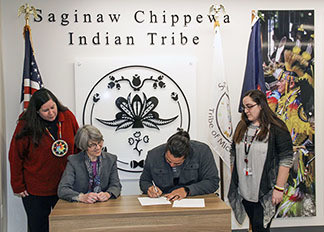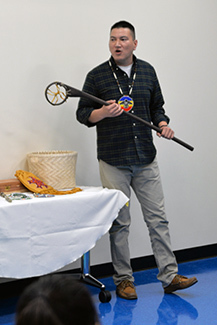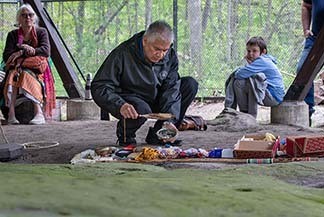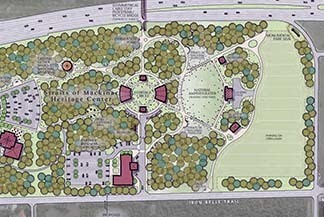Telling Michigan’s Anishinaabe history
By SANDRA CLARK
Michigan Department of Natural Resources

At a rest stop along U.S. Highway 2, 6 miles west of St. Ignace, the green and gold Michigan Historical Marker begins:
LAKE MICHIGAN
This lake, the sixth largest in the world, was discovered in 1634 by Jean Nicolet …
That is what our history books told us. But does the history of Lake Michigan really begin with a French explorer?
Of course not.
Anishinaabe people had known, traveled and fished the lake for centuries before Nicolet arrived. Although the marker credits Marquette and Jolliet with establishing “the general size and outline of the lake” in the 1670s, those Frenchmen relied on the knowledge of Native Americans who did not need printed maps to understand the shores, weather and dangers of the lake.The Michigan Historical Commission and the Michigan History Center are beginning an effort to expand the stories told on Michigan Historical Markers to include Native American people and others whose lives have too often been overlooked in exhibits and markers, as well as museum and archival collections.
|

“This important effort will take several years, but it will enrich how we in Michigan think about our heritage, and perhaps our future,” said Brian Egen, commission chairman.
The Michigan Historical Commission is appointed by the governor to advise the Michigan Department of Natural Resources on its Michigan History Center museums, archives and programs. The commission approves the text of all Michigan Historical Markers and takes a leadership role in that program.
For the history center, the marker project is part of its work with members of Michigan’s 12 sovereign tribal nations that began with the repatriation of ancestral human remains to the tribes after the 1990 passage of the federal Native American Graves Protection and Repatriation Act.
The occasional tribal and state staff conversation on text for historical markers and museum labels that followed intensified with a 2014 grant from the W.K. Kellogg Foundation.
The grant gave the center the means to begin rethinking the exhibits in the Michigan History Museum in Lansing, starting with the time before Native American contact with Europeans.
Odawa (Ottawa), Ojibwe (Chippewa) and Bodéwadmik (Potawatomi) colleagues have since been sharing knowledge and different ways of looking at the natural and cultural world with history center staff.
The first result of that collaboration was a new exhibit focused on the daily lives of the people who lived in Michigan for a thousand years before Europeans “discovered” America.
|

These people managed their environment based on beliefs about partnership with and connectedness to natural resources. They grew corn, beans and squash together to avoid depleting the soil. They turned clay into fired ceramics and knew when and how to remove sheets of birch bark from a tree without killing the tree.
The exhibit partnership evolved to include a national-award-winning public program series. The program, called “Rock Your Mocs,” in conjunction with the worldwide Native American and Indigenous Peoples movement, celebrated Native heritage in Michigan by clarifying and examining the challenges and intricacies of Native life in the 21st century.
The next Michigan History Museum project growing out of this collaboration will jump ahead to the descendants of those Anishinaabe people, who are today citizens of both their tribal nations and of Michigan.
Opening in the coming year, the exhibit will introduce visitors to their language, Anishinaabemowin, their traditions and their continuing efforts to live in harmony with the natural world.
This has been an amazing learning experience for everyone at the Michigan History Center. Check out a time lapse depiction of exhibit creation.
The ancestors of our Native colleagues persisted through treaties that were not honored, attempts first to remove them from their homelands and then to wipe out their culture systematically through Indian schools, and laws and practices that failed to acknowledge or respect their culture. Their stories need to be included in all parts of the museum, as do those of all Michiganders.
|

The history center provides historical interpretation and experiences at eight Michigan state parks and three museums across the state.
One historical site, Sanilac Petroglyph Historic State Park in Sanilac County, protects and interprets ezhibiigaadek asin (“written on stone”), the Native American teachings carved in stone some 1,400 years ago.
Last year, the Saginaw Chippewa Indian Tribe of Michigan and the DNR signed an agreement to co-manage this sacred place, the first such agreement in Michigan.
The partners jointly developed interpretation of the petroglyphs and the surrounding trails to introduce some of those teachings and Native knowledge of plants and trees. They also work together on management and preservation issues.
Though Sanilac is the site of ancient knowledge, preservation efforts include state-of-the-art technology. In 2018, in order to better understand the natural aging of the petroglyphs, a collaborative effort involving the State Historic Preservation Office, the Michigan Department of Transportation, the tribe and the DNR, created LiDAR (Light Ranging and Detection) images of all the carvings.
These three-dimensional laser images captured almost 3 billion data points that will be compared with new scans every five years.
At Straits State Park in Mackinac County, the DNR is part of a collaborative that includes the Sault Ste. Marie Tribe of Chippewa Indians, the Mackinac Straits Health System and Moran Township. Together they are creating new visitor experiences for the site of the Father Marquette National Memorial in St. Ignace.
|

The first phase of the project focuses on the powwow grounds and a new learning center. The goal is to create a place that inspires reflection, learning and healthy lifestyles through cultural and natural resource-based experiences built around the Anishinaabe and French heritage of the region.
In 2019, the history center received a Michigan Humanities Council grant to co-develop an annual Anishinaabe Heritage Day event at the Michigan History Museum.
Developed by advisors from several of Michigan’s federally recognized and state historic tribes, the program will celebrate Michigan’s rich indigenous history and culture, past and present, through talks, demonstrations and an art fair.
The event was scheduled to debut in 2020 in conjunction with Michigan Indian Day, recognized on the fourth Friday each September. However, due to the COVID-19 pandemic, the event is postponed until September 2021.
In lieu of the big event, the center hosted a webinar that discussed contributions that Michigan’s Anishinaabe people have made to our state, past and present.
The event featured Shannon Martin with the Match-E-Be-Nash-She-Wish Band of Pottawatomi Indians, Colleen Medicine with the Sault Ste. Marie Tribe of Chippewa Indians and Eric Hemenway with the Little Traverse Bay Bands of Odawa Indians. More than 300 people attended.
The program was recorded and is available on the history center’s Vimeo page at Vimeo.com/MichiganHistory.
Cecil Pavlat of the Sault Ste. Marie Tribe of Chippewa Indians has said, “We are obligated to honor our Ancestors, and we can do that by sharing who we are and where we come from.”
Across Michigan, tribal websites and cultural centers, such as the Ziibiwing Cultural Center near Mount Pleasant, are sharing Anishinaabe stories that are part of the heritage of everyone who lives in Michigan.
The Michigan History Center looks forward to continuing to be a partner in this important work.
|
Check out previous Showcasing the DNR stories in our archive at Michigan.gov/DNRStories. To subscribe to upcoming Showcasing articles, sign up for free email delivery at Michigan.gov/DNR.
/Note to editors: Contact: John Pepin, Showcasing the DNR series editor, 906-226-1352. Accompanying photos and a text-only version of this story are available below for download. Caption information follows. Credit Michigan Department of Natural Resources, unless otherwise noted.
Text-only version - Native Americans
Ceremony: William Johnson, curator with the Ziibiwing Center of Anishinabe Culture and Lifeways, is pictured at a Little People Ceremony at the Sanilac Petrogyphs in 2019.
Exhibit: The new exhibit at the Michigan History Museum in Lansing includes a large mural that depicts the lifeways of Great Lakes Anishinaabe prior to European contact.
Marker: The Great Lakes historical markers, including the Lake Michigan marker, are being rewritten and will be replaced in 2021. Funding for the replacements is being provided by the Michigan Department of Transportation. (Photo credit: Archives of Michigan)
Rendering: An early rendering of the new heritage plan for Straits State Park, which is intended to inspire reflection, learning and healthy lifestyles built around the Anishinaabe and French heritage of the region.
Rock: Marcus Winchester, director of language and culture with the Pokagon Band of Potawatomi, discusses traditional skills during a 2016 “Rock Your Mocs” program.
Signing: On Dec. 2, 2019, Saginaw Chippewa Tribal Chief Ronald F. Ekdahl was joined by Sandra Clark, director of the Michigan History Center, at the signing of a memorandum of understanding to establish the co-management of the Sanilac Petroglyphs Historic State Park in Sanilac County./
|